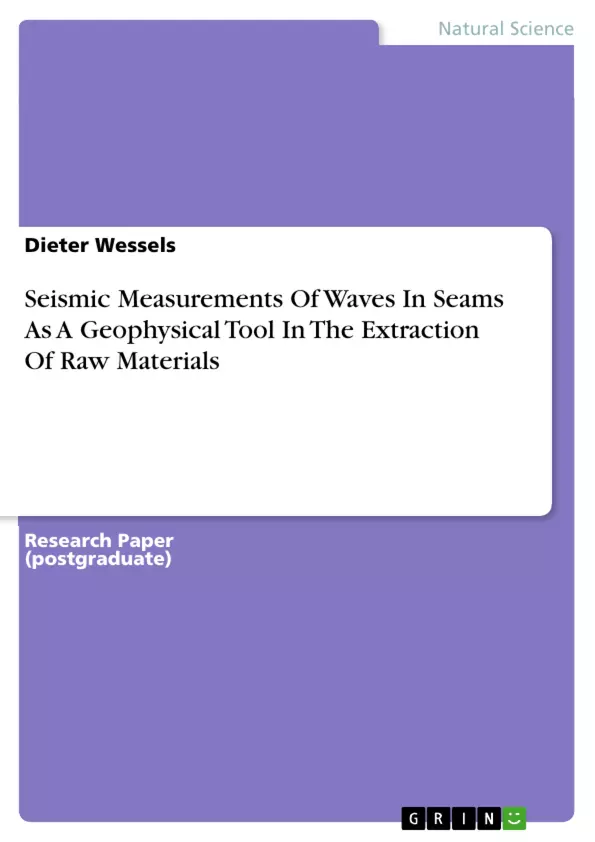With the increasing automation of mining, the underground mining forecourt mining is becoming increasingly important. In order to determine the tectonic content of the apron, a weather-protected measuring system was developed, which detects the position of disturbances by seismic channel waves.
There are two methods for mapping:
1. The Through-Transmission Measurement provides information about a fault in the seam
2. The reflection measurement provides information about the situation.
A great sense of accuracy can be achieved with combined use of both methods. The analysis of 111 measurements shows that geological conditions made the accuracy of the measurements very good, while in geologically complex structures the location of the disturbance proved to be very difficult.
The loss of resolution associated with envelope formation prevents the detection of clutter. To remedy this situation, the reflected Flözwellenzug must be attributed to a needle pulse. Theoretical investigations confirm this approach.
Since flute waves are subject to absorption - the higher the frequency, the stronger the absorption - and the loss of energy in reflection occurs, research in this area still needs to be done in order to use the insights gained in data processing. Remedies cause a spatial distribution of energy and thus complicate the indication of a possible disorder. This shows that complex geological structures have to be further investigated by model seismic investigations. This requirement is underlined by the high costs of underground measurement, which depending on the length of the track to be measured amount to 50,000 DM to 150,000 DM
Inhaltsverzeichnis (Table of Contents)
- Introduction
- Theoretical Basics
- Measuring Principles
- Reflection Measurements
- Through-transmission Measurements
- Measuring Equipment And Implementation Of Measurements
- Susceptibility To Interference Of The Measuring-System
- In The Apparatus
- In The Measuring-System
- Measurement Results In The Acquisition Of Disturbances And Measurements With Special Objective
- Evaluation Of Measurement Results
- Future Development
- Summary
Zielsetzung und Themenschwerpunkte (Objectives and Key Themes)
The objective of this work is to explore the potential of seismic measurements of waves in seams as a tool for forecasting the homogeneity of raw materials in planned mining operations. This method aims to provide a safe and reliable way to predict geological disturbances that can hinder or halt production. The study focuses on the application of seismic measurements in the context of the German coal industry, where the costs associated with geological disturbances are significant.
- Seismic measurements as a tool for forecasting geological disturbances in seams
- The importance of exploring the homogeneity of raw materials in planned mining operations
- The economic impact of geological disturbances on mining operations
- The application of seismic measurements in the context of the German coal industry
- The theoretical and practical aspects of seismic measurements of waves in seams
Zusammenfassung der Kapitel (Chapter Summaries)
- Introduction: This chapter sets the stage by highlighting the significant economic impact of geological disturbances in the German coal industry. It introduces the concept of seismic measurements as a tool for predicting such disturbances and emphasizes its importance for ensuring efficient and cost-effective mining operations.
- Theoretical Basics: This chapter delves into the theoretical foundations of seismic measurements, explaining the underlying principles and concepts that govern the propagation of waves in seams. It lays the groundwork for understanding the technical aspects of the measurement method.
- Measuring Principles: This chapter focuses on the specific techniques used in seismic measurements, exploring both reflection and through-transmission methods. It provides a detailed explanation of the various approaches and their applications in different scenarios.
- Measuring Equipment And Implementation Of Measurements: This chapter examines the instruments and procedures involved in conducting seismic measurements. It discusses the design and operation of the measuring equipment, as well as the practical steps involved in setting up and carrying out the measurements.
- Susceptibility To Interference Of The Measuring-System: This chapter addresses the potential sources of interference that can affect the accuracy and reliability of seismic measurements. It analyzes the factors that can introduce noise or distortion into the measurements, both within the measuring apparatus and the broader measuring system.
- Measurement Results In The Acquisition Of Disturbances And Measurements With Special Objective: This chapter presents examples of seismic measurements conducted to identify and characterize geological disturbances. It showcases the practical applications of the method and highlights its effectiveness in detecting and analyzing potential problems.
- Evaluation Of Measurement Results: This chapter explores the process of analyzing and interpreting the data obtained from seismic measurements. It describes the techniques used to extract meaningful information from the measurements and to assess the potential risks associated with geological disturbances.
- Future Development: This chapter discusses potential avenues for further development and refinement of the seismic measurement technique. It explores new technologies and approaches that could enhance the accuracy, efficiency, and scope of the method.
Schlüsselwörter (Keywords)
The main keywords and focus topics of this work are seismic measurements, waves in seams, geological disturbances, raw materials, mining operations, German coal industry, homogeneity, forecasting, economic impact, theoretical basics, measuring principles, measuring equipment, interference, data analysis, and future development. These terms encompass the core concepts and research focus of the study, providing a framework for understanding the application of seismic measurements in the extraction of raw materials.
- Quote paper
- Dipl.-Ing. Dieter Wessels (Author), 1990, Seismic Measurements Of Waves In Seams As A Geophysical Tool In The Extraction Of Raw Materials, Munich, GRIN Verlag, https://www.hausarbeiten.de/document/432632


